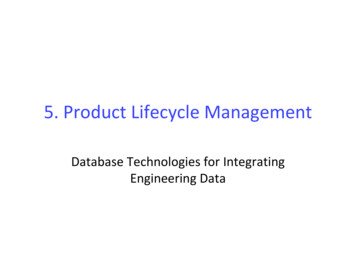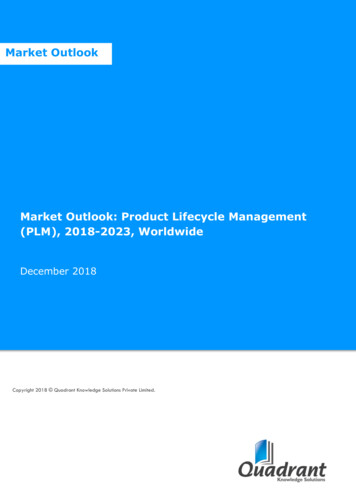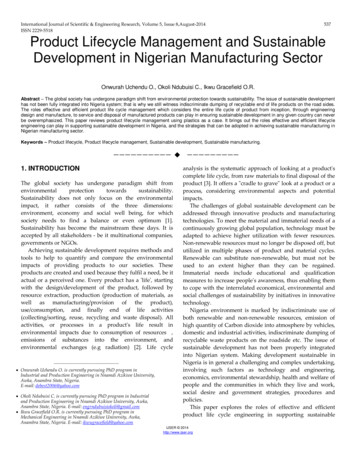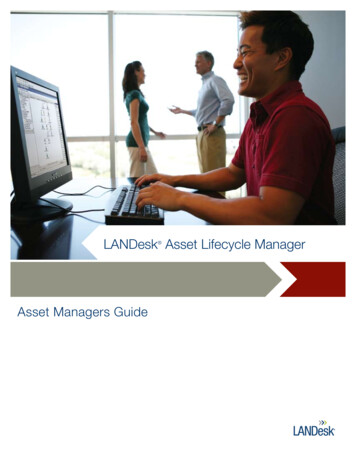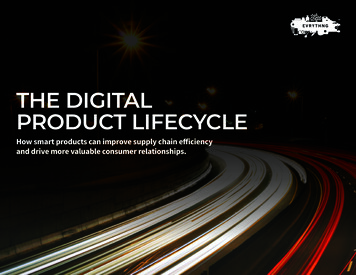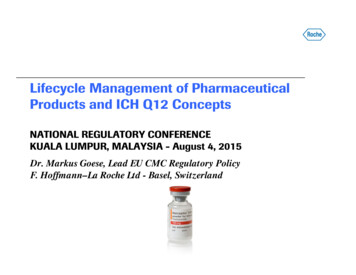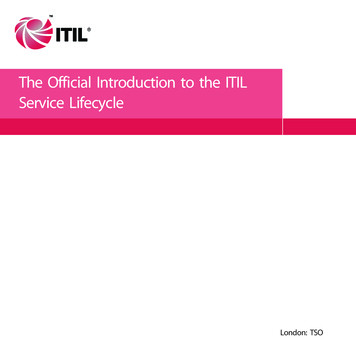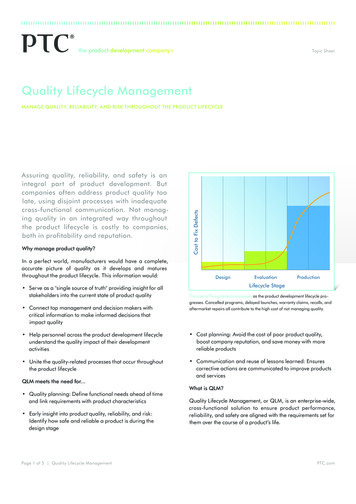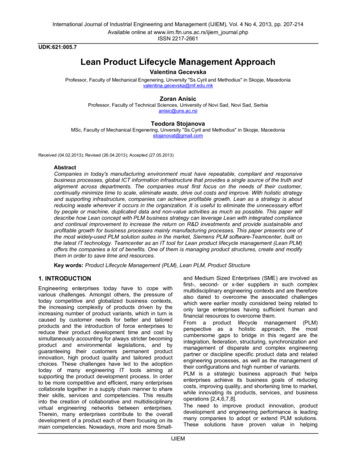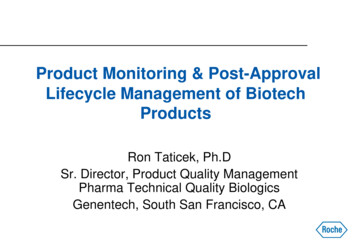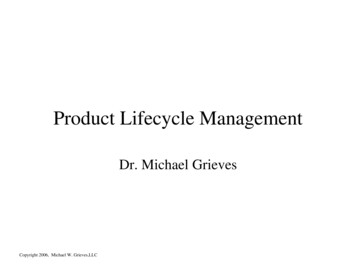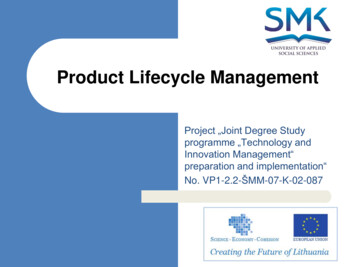
Transcription
Product Lifecycle ManagementProject „Joint Degree Studyprogramme „Technology andInnovation Management“preparation and implementation“No. VP1-2.2-ŠMM-07-K-02-087
Chapter 1.What is Product Life Cycle? (I) Different marketing strategies -which will beused in that system- should be appliedaccording to the product, environment,competitor, the company’s position. Allproducts have a short term or long term lifeand new life cycle starts from when this lifeended up. That cycle includes five steps.
What is Product Life Cycle? (II) Product Life Cycle Management (PLM)addresses the full life cycles of products, fromconception until disposal. The first call wasmade in 2000 by IBM. The most importantstarting point for PLM is the launch of the newconcept above traditional cost-quality - theprocess of supply triangle.
What is Product Life Cycle? (III) PLM includes that a product of all theengineering, manufacturing and information ofmaintenance, digital media store, check.PLMstarts from the creation of a product andfinishes with re - transformation of product. Atthe same time this system can offer theproducts to different user profiles. The creationof the product determines largely what can bedone with the product in the later life cyclephases.
The aim of PLM PLM always tries to reduce loss of energy,materials, work force. So, PLM brings togethervery professional engineering disciplines.Because of that different groups, these lossescan be optimized and also PLM contributes toa new generation of lean thinking. PLM usetwo strategies to make a real result. These areefficiency and innovation.
Main Components andFigures of PLMThe Main Components:Data management: It enables appropriate stage for management.It provides information about product features, bills of material,data distribution, project structure.Program and project management: It’s about the process ofdeveloping a product. It gives information on planning,management and checking.Cooperation: It supports project management and it relies on WEBstandards which are based on XML(Extensible Markup Language)Quality management: It provides an integrated qualitymanagement for each sector.Management of corporate assets: It directs equipment and physicalassets
The Main Figures of PLMIntroduction (from conception to disposal)Product life cycle management processBusiness (the money dimension)Heart beat of changes (the time dimension)Complexity (huge number of configurations)Conclusion
LCM Phases (I)Annual lifecycle status reviewapprox 10 yearsProduct isreleased for saleLifecycleannouncement 6 months 12 monthsActiveGuaranteed product nnouncementClassicLifecycleannouncement6 monthsLimitedObsoleteLimited product support standard development, production and sale. maintenance phase of the product: availability is guaranteed for replacing in existing plants. spare parts are available. The production of the CB's whole range is not guaranteed and the technicalsupport is limited. technical support is no more guaranteed. The production of the CB's whole range has ended but sparemight be available. Retrofit solutions are available.
LCM Phases (II)ActiveActive development andpromotion phaseClassicLimitedProduct maintenance phasePrimarily service support No further enhancements Product is no longer activelyPromoted, 12month advancenotice through sales channelThe manufacture of spare partsand accessories is guaranteed new apparatus availability maycontinue, but is not guaranteedProduct will be phase out increasing use of refurbishedapparatus or retrofitting kits Product has been released forsale Actively promoted Product is actively sold Product is actively maintainedwith enhanced through R&D orproduct improvements Fully supported of after salesnetworkIt is still available for sale - mainlyfor spares and expansions of no new development to replaceexisting systems, supply underobsolete componentsframe agreements, in case of space Technical support (field service,constrains, required functionalityphone support, etc) continues, butnot yet covered by the new product,may diminish over time withlicense agreementsdecreasing installed base Price may increase (e.g. due tolower volume, vendor componentcosts, etc.)ObsoleteObsolete phase ABB cannot guaranteeavailability of product supportfor technical reasons or withinreasonable costs. No longer manufactured as acomplete product; onlycomponent spares, refurbishedapparatus, retrofit and/orrevamping solutions available
Customer support over the lifecycleand beyondActiveClassicLimitedObsoleteAvailability of service offerings is subject to local market conditions.Lifecycle Training &Traininge-Learning& e-LearningOperate andmaintainTechnical Support & remote serviceParts & repairMaintenanceRebuild orreplaceRetrofitReplace & recycling
Which factors havean impact on PLM?External Factors Scale: Companies want to grow continuously. Complexity: The diversity of product increases because ofproduct and the process of production. Time of cycle: It’s important for competition. Lean production: It’s about using less energy and material. Global competition: The competition has increasedsignificantly. The arrangements made by governments and internationalagreements: It’s about environmental degradation, work andarrangement of job security.
Internal factors of PLM
What are the sub-softwares? Product Portfolio Management (PPM)Computer Aided Design / Engineering /Manufacturing (CAx)Product Data Management (PDM)Manufacturing Process Management (MPM)Digital Manufacturing (DM)
What are the solutions of PLM?oooooooooPLM Solutions are organs. It has been developed for theimprovement of organization by IT(Information Technology)Work to rely on customerResponding quickly to changing market conditionsShortening the duration of the market to offer newproductsWorkflow that allows optimization of productReduction in the cost of prototypeContinuous innovation process and implement newtechnologies effectivelyReduction of wasteBeing in closer contact with customers and suppliers
Current Information Model of PLM
What are the advantages of thissoftware? to simulate the developed modelto design the product before the other companiesto pull down the costto save from time and energyto increase competitiveness in the worldto create higher quality products.to launch new products in less time, at a lower cost.to understand what change really costs in terms of time andmoneyto control your production processes and not let themcontrol you.to increase profits and market share.
Collaboration environment and datastorage of product lifecyclemanagement
Research and Development In that level; Companies decide for cost ofproduct and problems of service.%80 ofproduct costs are determined at this stage.Products are designed, made a prototype andtested for needs of various users. The mostappropriate marketing method is doing nothingabout the product sales. Because; there is nota product yet.
Basic system of Product Lifecycle
Introduction (Offer)In that level, large budgets must be separated forpromotion because it is the first time of product –market meeting.So word of mouth marketing is not possible eventhe product is so qualified. The size of the budgetinfluences the length of product life cycle.The new product does not produce profit due tocosts of supply and promotion.20
Growth21If the product is fit for market, companies canpass this level.In that level, Companies begin to obtainrevenue. The price of the product can be thesame at the beginning or it can be change.The cost of marketing should be stable andalso you have to invest for improving yourproduct's features. Expansion of distributionlines reach to the new customers profile. Afterall that, rate of profit is going to pick-up.
MaturityThis level starts from the rate of sales decline.Competition increases between sellers.The rivals try to reduce prices while the cost ofproduction is falling. In this way weakopponents pull out from the market.22
DeclineIn that level; the rate of sales reduces visibly. Thereasons of decline are technological developments,opponents who gain experience and strong etc. Atthe end of this stage the companies need to knowthe idea of customers about product. Because theyneed that feedback system to improve theirproduct.23
Chapter 2. Product The Best Way to hold customers is toconstantly figure out how to give them more orless.
The learning objectives ProductProduct classificationProduct life-cycle strategiesNew-product DevelopmentProduct-line decisionBrands decisions
1. What is product? Anything that can be offered to a market forattention,acquisition,use,or consumption thatmight satisfy a want or need.
Components of theMarket OfferingValue-based pricesAttractiveness ofthe market offeringProduct featuresand qualityServices mixand quality
Service and Experience Service - Any activity or benefit that one partycan offer to another that is essentiallyintangible and does not result in the ownershipof anything.
Five Product LevelsPotential productAugmented productExpected productBasic productCore benefit
Levels of Product Core productActual productAugmented product
Core product Core benefit or service
Actual product Quality levelFeaturesDesignPackageBrand name
Augmented product InstallationAfter-sale serviceWarrantyDelivery and creditAttached benefit
2. Product classifications Consumer productsIndustrial productOrganizations, persons, places, and ideas
Consumer product Convenience productsShopping productsSpecialtyunsought
Consumer-Goods ClassificationConvenience ProductsShopping ProductsBuy frequently & immediately Low priced Many purchase locations Includes: Staple goods Impulse goods Emergency goodsBuy less frequently Gather product information Fewer purchase locations Compare for: Suitability & Quality Price & StyleSpecialty ProductsUnsought ProductsSpecial purchase efforts Unique characteristics Brand identification Few purchase locationsNew innovations Products consumers don’twant to think about. Require much advertising &personal selling
Industrial Product Material and partsCapital itemsSupplies and services
Chapter 3. Product Life Cycles(PLC) The course of a product’s sale and profit over itlifetime.It involves five distinct rity,anddecline.
Product Life Cycle Phases
Product Life-Cycle Strategies The product life cycle concept can beapplied to a:–––Product class (soft drinks)Product form (diet colas)Brand (Diet Dr. Pepper) Using the PLC to forecast brandperformance or to develop marketingstrategies is problematic10- 40
Product Life-Cycle StrategiesPLC Stages Productdevelopment Introduction Growth Maturity DeclineBegins when thecompany developsa new-product idea Sales are zero Investment costsare high Profits are negative 10- 41
Product Life-Cycle StrategiesPLC Stages Productdevelopment Introduction Growth Maturity DeclineLow sales High cost percustomer acquired Negative profits Innovators aretargeted Little competition 10- 42
Marketing Strategies: IntroductionStage Product – Offer a basic productPrice – Use cost-plus basis to setDistribution – Build selective distributionAdvertising – Build awareness among earlyadopters and dealers/resellersSales Promotion – Heavy expenditures tocreate trial10- 43
Product Life-Cycle StrategiesPLC Stages Productdevelopment Introduction Growth Maturity DeclineRapidly rising sales Average cost percustomer Rising profits Early adopters aretargeted Growingcompetition 10- 44
Marketing Strategies:Growth Stage Product – Offer product extensions, service,warrantyPrice – Penetration pricingDistribution – Build intensive distributionAdvertising – Build awareness and interestin the mass marketSales Promotion – Reduce expenditures totake advantage of consumer demand10- 45
Product Life-Cycle StrategiesPLC Stages Productdevelopment Introduction Growth Maturity DeclineSales peak Low cost percustomer High profits Middle majority aretargeted Competition beginsto decline 10- 46
Marketing Strategies:Maturity Stage Product – Diversify brand and modelsPrice – Set to match or beat competitionDistribution – Build more intensivedistributionAdvertising – Stress brand differences andbenefitsSales Promotion – Increase to encouragebrand switching10- 47
Product Life-Cycle StrategiesPLC Stages Productdevelopment Introduction Growth Maturity DeclineDeclining sales Low cost percustomer Declining profits Laggards aretargeted Decliningcompetition 10- 48
Marketing Strategies: DeclineStage Product – Phase out weak itemsPrice – Cut priceDistribution – Use selective distribution:phase out unprofitable outletsAdvertising – Reduce to level needed toretain hard-core loyalistsSales Promotion – Reduce to minimal level10- 49
Sales & profits ( )Sales & Profit Life CyclesIntroductionGrowthMaturityTimeDecline
Introduction stage The product life-cycle stage in which the newproduct is first distributed and made availablefor purchase.
Four IntroductoryMarketing enetrationstrategyPriceLow
Growth stage The product life-cycle stage in which aproduct’s sales start climbing quickly.
Maturity stage The stage in the product life cycle in whichsales growth slows or levels off.Modify the market,the product,and themarketing mix.
Decline Stage The product life cycle stage in which aproduct’s sales decline
Alternative product life cycles
Discussion Please list the marketing objectives and strategies foreach stage.2.what strategic option are open to the marketers ofproducts in the mature stage of the product life cycle?3.which product life-cycle stage, if any,is the mostimportant?which stage is riskiest?which stage appearsto hold the greatest profit potential? Be certain toexplain the thinking behind each of your answer.
Chapter 4.New-product development Understand how companies find and developnew-product ideas.Learn the steps in the new-productdevelopment process.Know the stages of the product life cycle.Understand how marketing strategies changeduring the product’s life cycle.
What is new product? Original productsProduct improvementsProduct modificationsNew brands that the firm develops through itsown research and development efforts
Discussion Question Why do products fail? See if you can identify the fatal flaw in thebrands below and at right.
Major stages in new productdevelopment Idea generationIdea screeningConcept development and testingMarketing strategiesBusiness analysisProduct developmentTest marketingCommercialization
New Product eptDevelopmentand ProductDevelopmentMarketTestingCommercialization
Probability of SuccessOverallprobabilityof success Probabilityof technicalcompletionXProbability ofcommercializationgiven technicalcompletionProbability ofeconomicsuccess givencommercializationX
Concept Development & Testing1. Develop Product Ideas intoAlternative Product Concepts2. Concept Testing - Test the ProductConcepts with Groups of Target Customers3. Choose the Best One
ExpensiveHigh stantbreakfastInexpensiveLow in caloriesb) Brand-positioningmap(instant breakfast market)Brand CBrand BBrand ALow price/oz.High in calories(a) Product-positioningmap(breakfast market)QuickSlowProduct & Brand Positioning
Conjoint AnalysisBrand nameUtility1.0 ----- 0Glory Bissell 1.19 1.39Good Housekeeping Seal?1.0----- 0NoYes Money-BackGuarantee?1.0----- 0 NoYes 1.59UtilityUtilityUtility1.0 -----0 K2R Retail Price
Consumer-Goods Market TestingSimulatedTest MarketTest in a simulatedshopping environmentto a sample ofconsumers.SalesWaveResearchTest offering trail toa sample ofconsumers insuccessiveperiods.ControlledTest MarketA few stores that haveagreed to carry newproducts for a fee.StandardTest MarketFull marketing campaignin a small number ofrepresentative cities.
Adopter Categorization of the Basis ofRelative Time of Adoption of Innovations34%Earlymajority2 1/2%Innovators13 1/2%Earlyadopters34%Latemajority16%LaggardsTime of adoption innovations
Five categories and profiles ofproduct adopters
Chapter 5. Product-line decision Product mixProduct-line analysisProduct –line length
Product mix(assortment) (I) The set of all products and items that aparticular seller offers for sale.A company’s product mix has a certainwidth,length,depth, and consistency.
Product mix(assortment) (II) Width:how many different product lines.Length:the total number of items.Depth:how many variants are offered of eachproduct in the line.Consistency:how closely related the variousproduct lines are in end use,productionrequirement,distribution channels, or someother way.
Product MixWidth - number ofdifferent productlinesLength - totalnumber of itemswithin the linesDepth - number ofversions of eachproductProduct Mix all the productlines offered
Product-line analysis Sales and profitMarket profile
Product-Line Length Line Stretching––– DownmarketUpmarketTwo-wayLine FillingLine ModernizationLine Featuring & Line Pruning
Line stretching Downmarket stretchUpmarket stretchTwo-way stretch
Two-Way Product-Line Stretch:Marriott averageAverageFairfield InnLow (Vacationers)SuperiorCourtyard(Salespeople)
Chapter 7. Product Life Cyclesand the Boston Matrix ationDeclineTime
Product Life Cyclesand the Boston Matrix (II)SalesEffects of ExtensionStrategiesTime
Product Life Cyclesand the Boston Matrix (III)Sales/ProfitsPLC and ProfitsPLCProfitsTimeLossesBreak Even
The Boston Matrix (I)–––A means of analysing the product portfolio andinforming decision making about possible marketingstrategiesDeveloped by the Boston Consulting Group – abusiness strategy and marketing consultancy in1968Links growth rate, market share and cash flow
The Boston Matrix (II)LowProblem ChildrenStarsDogsCash CowsMarket ShareHigh
Stars Products in markets experiencing high growthrates with a high or increasing share of themarketPotential for high revenue growth
Cash Cows:––––High market shareLow growth markets – maturity stage of PLCLow cost supportHigh cash revenue – positive cash flows
Dogs:––––Products in a low growth marketHave low or declining market share (declinestage of PLC)Associated with negative cash flowMay require large sums of money to support
Problem Child:--Products having a low market share in a highgrowth marketNeed money spent to develop themMay produce negative cash flowPotential for the future?
The Boston Matrix Implications:Dogs:–––––Are they worth persevering with?How much are they costing?Could they be revived in some way?How much would it cost to continueto support such products?How much would it cost to removefrom the market?
The Boston Matrix Implications:Problem Children:–––What are the chances of these products securing aholdin the market?How much will it cost to promote them to a strongerposition?Is it worth it?
The Boston Matrix Implications:Stars:––––Huge potentialMay have been expensive to developWorth spending money to promoteConsider the extent of their product life cycle indecision making
The Boston Matrix Implications:Cash Cows:–––––Cheap to promoteGenerate large amounts of cash –use for further R&D?Costs of developing and promotinghave largely goneNeed to monitor their performance –the long term?At the maturity stage of the PLC?
The Product Life Cycle and the BostonMatrix (I)The productportfolio – fourproducts in theportfolioSales(1)(2)(3)DABCTime
The Product Life Cycle and theBoston Matrix (II) Importance of maintaining a balance ofproducts in the portfolio at different stages ofthe PLC – Boston Matrix helps with the analysis1) ‘A’ is at maturity stage – cash cow.Generates funds for the development of ‘D’(2) Cash from ‘B’ used to support ‘C’ throughgrowth stage and to launch ‘D’. ‘A’ now possiblya dog?(3) Cash from ‘C’ used to support growth of ‘D’and possibly to finance extension strategy for‘B’?
Managing the product life cycle Modifying the Product– Product ModificationModifying the Market–Market Modification Finding New UsersIncreasing UseCreating New Use Situations
Managing the product life cycle Repositioning the Product Product Repositioning Reacting to a Competitor’s Position Catching a Rising Trend Changing the Value Offered Trading Up Trading Down Downsizing
Concept Check1. What does “creating new use situations”mean in managing a product’s life cycle?A: Finding new uses or applications foran existing product.
Concept Check2. Explain the difference between trading upand trading down in repositioning.A: Trading up involves adding value to the product(or line) through additional features or higherquality materials. Trading down involvesreducing the number of features, quality, orprice, or downsizing—reducing the content ofpackages without changing package size andmaintaining or increasing the package price.
Chapter 7. Brand Decision What is brand?Band decision
What is brand? Brand is a name,term,sign,symbol,or design,ora combination of them,intended to identify thegoods or services of one seller or group ofsellers and differentiate them from those ofcompetitors.
What is a es
Discussion What is difference between product and brand?How to define the line cycle of a brand?
An Overview of Branding DecisionsBrandingDecision Brand No ndStrategy RepositioningDecisionDecision Manufacturerbrand Individualbrandnames Blanketfamilyname Separatefamilynames Companyindividualnames Lineextension Brandextension Multibrands Newbrands Cobrands Distributor(private)brand Licensedbrand Repositioning Norepositioning
Brand decision 1.to brand or not to brand?2.brand-sponsor decision3.Brand-name decision4.brand-strategy decision5.brand-reposition decision
Brand-sponsor decision Manufacturer brandDistributor brandLicensed brand
Brand-name decision IndividualBlanket familySeparated familyCompany-individual family
Good Brand Names:Lack ctQualitiesSuggestProductBenefitsEasy to:PronounceRecognizeRemember
Brand StrategiesBrand NameProduct sionNewMultibrandsNewBrands
Brand-strategy decision Line extensionsBrand extensionsNew brandscobrands
Brand-reposition decision RepositionNo reposition
Why Package Crucial as aMarketing Tool Self-serviceConsumer affluenceCompany & brand imageOpportunity for innovation
LabelsPromoteDescribeIdentify
Chapter 8. Product LifecycleManagement: Ideation and InnovationThe Knowledge Economy is being eclipsed by the CreativityEconomy.The new core competence is Creativity. It isn't just about mathand science anymore. It's about creativity, imagination, and,above all, innovation. The knowledge is being commoditized.The U.S. is the leader in the Creativity Economy - for themoment.
Creativity EconomyThe new forms of innovation driving CreativityEconomy forward are based on an intimateunderstanding of consumer culture - the ability todetermine what people want even before theycan articulate it.
Innovation “Definition” “The successful exploitation ofideas, into new products,processes, services or businesspractices” (DTI Innovation Unit) “It is about people creating valueby implementing new ideas”(Innovation mlhttp://www.thinksmart.com/mission/dna/
Components of SuccessfulInnovation A "people dependent",collaborative skill involving––––––scouting the futuregenerating new ideaschoosing the bestrapidly and effectivelyimplementing andthen learning the lessonsfrom successes and failuresin order to begin againEnabling Innovative Organizations (EIO): http://www.mindman.net/innovation/index.asp .
The Importance of Being First-to-Market Being first in any market category is going togive you the edge – being the leader comesfrom being first.It's much easier to get into the mind ofconsumers first that try to convince people youhave a better product.The Importance of Being First-to-Market http://www.1000ventures.com/business guide/product devt new-to-the-world.html
Cycle of InnovationRepeating innovation is critical to sustainingabove average long term profits.Innovation Creators: http://innovationcreators.com/wp/?p 8 .
Global Innovation Opportunities The Internet and high-speed data networksoffer solutions to typical innovation problems:––––creativity managementnew product developmentproduct life cycle managementenabling organizations to tackle the dailychallenges of gent-innovation/
Building Innovation as a Capability Critical success factors in buildingInnovation as a capability withinthe Organization:– Leadership and Followership– Climate and Environment– Structured Idea ManagementProcess that gathers ideasfrom Employees, Customersand Supply Chain p
People Drive Innovation Revolutionary Thought Leaders Revolutionary Thinking Seminar Free to Win p
Multidisciplinary Teams Multidisciplinary teams are the heart of any innovation method. Quite simply, great work is accomplished by “Hot Teams”. Teams include people from various disciplines:––––––––––Human FactorsMechanical/Electrical EngineeringManufacturingHealthcareBusiness FactorsKid-Centric DesignIndustrial DesignEnvironmentsInteraction DesignSoftware Engineeringhttp://www.ideo.com/about/index.asp?x 1&y 1
Climate and Environment Creating compelling visions Ideation and Creativity sessions Innovation Recognition Program Positive Reinforcement System asp
Innovation Method Observation Brainstorming Prototyping x 3&y 1
Observation User observations are the startingpoint for every design program. Designers are seasoned observersof people and how they interact withthe world. The users are engaged throughoutthe design process to evaluate thedesirability of new ideas andpossible sp?x 1
Brainstorming ”The best way to get a good idea is to get a lot ofideas." - Linus Pauling "Be Visual. Defer judgment. Encourage Wild Ideas.Build on the Ideas of Others. Go for Quantity. OneConversation at a Time. Stay Focused on theTopic.“ Brainstorming is not just a good idea but aninexhaustible source of inspiration and fo.asp?x 2
Prototyping Prototyping is the language ofinnovation. Prototyping is problem-solvingin three dimensions. One canprototype just about anything— a new product or service, awebsite or a new space.http://www.ideo.com/about/methods/info.asp?x 3
Implementation Implementation completes the cycle of ideation todrive the concept to its final form. All the possibilities have been evaluated, theprototypes validated and refined, and what's left isto do it. The project team performs detailed design andengineering, chooses manufacturing partners ifnecessary, and works with the client to perform atimely and successful x 4
THE END
Product Lifecycle Management . Chapter 1. . Product Life Cycle Management (PLM) addresses the full life cycles of products, from conception until disposal. The first call was made in 2000 by IBM. The most
